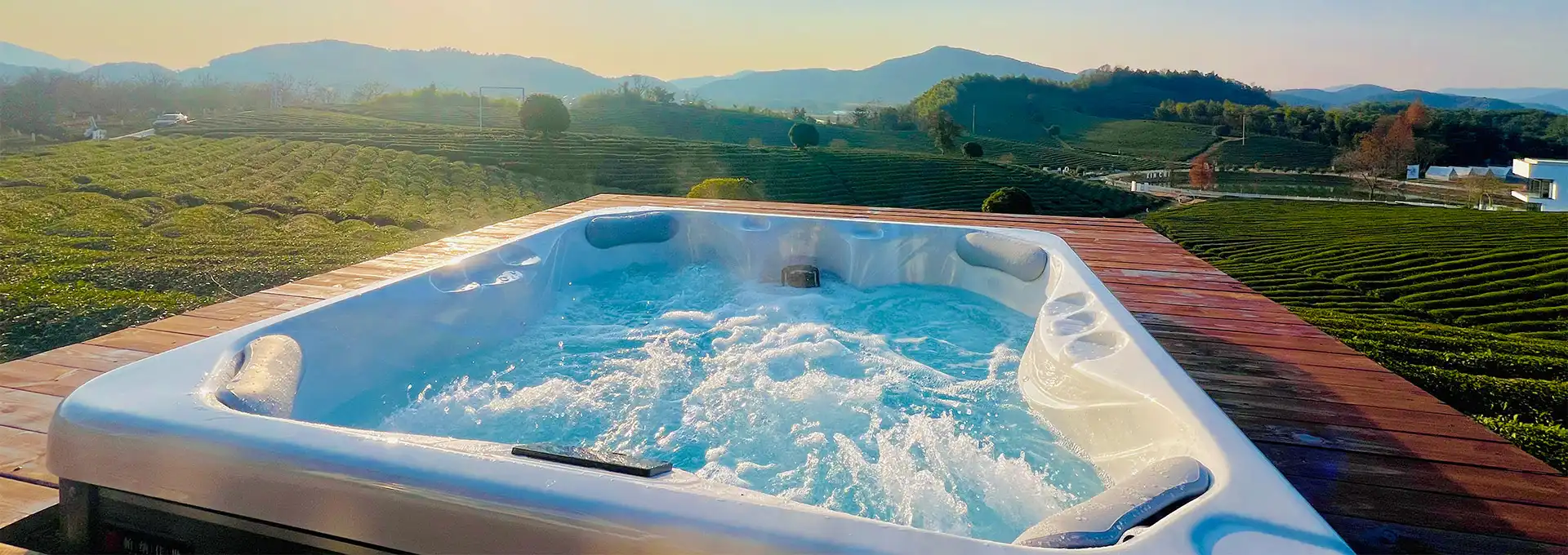What is a Stand Alone Hot Tub?
2025-06-27 16:33:34
A stand alone hot tub, also known as a portable or freestanding hot tub, is a self-contained hydrotherapy unit that can be installed virtually anywhere without requiring permanent plumbing or electrical connections to your home's infrastructure. Unlike built-in spas that are integrated into decks or permanently installed in backyards, a stand alone hot tub offers the flexibility of relocation and easier installation. These versatile wellness units typically feature their own heating system, filtration equipment, and control panels, making them an attractive option for homeowners seeking relaxation and therapeutic benefits without the commitment of a permanent installation.
How much does it cost to run a stand alone hot tub?
Initial Purchase and Installation Costs
The cost of acquiring a stand alone hot tub varies significantly based on size, features, and brand quality. Entry-level models typically range from $3,000 to $6,000, while premium units with advanced features can cost between $8,000 and $15,000 or more. Installation costs are generally lower than built-in alternatives since stand alone hot tubs require minimal site preparation. Most units simply need a level, stable surface and access to electrical power. Professional installation services typically charge between $500 to $1,500, depending on electrical requirements and site accessibility. The hot tub's portability means you can often handle basic setup yourself, though professional installation ensures proper electrical connections and optimal performance.
Monthly Operating Expenses
Operating a stand alone hot tub involves several ongoing costs that homeowners should consider. Electricity consumption represents the largest expense, typically ranging from $30 to $100 monthly, depending on usage frequency, local utility rates, and seasonal temperatures. Water heating accounts for approximately 80% of energy costs, while pumps and filtration systems consume the remainder. Chemical treatments for water maintenance cost approximately $20 to $40 monthly, including sanitizers, pH adjusters, and shock treatments. The hot tub's insulation quality significantly impacts operating costs, with well-insulated models reducing energy consumption by up to 30% compared to poorly insulated alternatives.
Long-term Maintenance and Replacement Costs
Maintaining a stand alone hot tub requires periodic component replacements and professional servicing to ensure optimal performance and longevity. Filter replacements typically cost $30 to $60 every three to four months, while annual professional maintenance services range from $150 to $300. Major component replacements, such as pumps, heaters, or control systems, may be necessary every 5 to 10 years, with costs ranging from $300 to $1,200 per component. However, regular maintenance can significantly extend component lifespan and reduce unexpected repair costs. The hot tub's warranty coverage and manufacturer reputation play crucial roles in long-term cost management and overall ownership satisfaction.
What size stand alone hot tub do I need?
Determining Capacity Based on Usage
Selecting the appropriate size for your stand alone hot tub depends primarily on how many people will regularly use it and your available space. Compact 2-3 person hot tubs measure approximately 5-6 feet in diameter and are ideal for couples or small families with limited space. Mid-size 4-6 person models typically measure 7-8 feet across and accommodate most family needs while maintaining reasonable operating costs. Large 7-8 person hot tubs can exceed 8 feet in diameter and are perfect for entertaining guests or larger families. Consider that while larger hot tubs offer more space, they also require more water, chemicals, and energy to operate, significantly impacting long-term costs and maintenance requirements.
Space Requirements and Site Considerations
Beyond the hot tub's physical dimensions, adequate clearance space is essential for safe operation and maintenance access. Most manufacturers recommend at least 2-3 feet of clearance on all sides for proper ventilation and service access. The total footprint should also account for steps, safety railings, and any desired deck or patio integration. Foundation requirements vary by model size, with larger stand alone hot tubs requiring more substantial support structures. Consider delivery access routes, as larger models may require crane installation or special delivery arrangements. The hot tub's weight when filled can range from 3,000 to 6,000 pounds, necessitating proper ground preparation and structural support evaluation.
Features and Functionality Considerations
Modern stand alone hot tubs offer various features that may influence size selection beyond basic capacity needs. Larger models typically accommodate more jets, advanced seating configurations, and additional features like LED lighting, built-in sound systems, or cascading waterfalls. However, more features generally mean higher purchase prices and increased operating costs. Consider which features are essential versus nice-to-have amenities when determining your ideal hot tub size. The hot tub's intended primary use—whether for relaxation, hydrotherapy, or entertainment—should guide your decision-making process. Therapeutic users may prioritize specific jet configurations and seating arrangements over maximum capacity.
Can you move a stand alone hot tub?
Preparation and Planning for Hot Tub Relocation
Moving a stand alone hot tub is entirely possible, though it requires careful planning and proper equipment to ensure safe transportation. The relocation process begins with completely draining the hot tub and disconnecting all electrical connections, which should be performed by qualified professionals to avoid safety hazards. Remove all accessories, covers, and loose components before the move. The hot tub's weight without water typically ranges from 400 to 1,000 pounds, making professional moving services advisable for most homeowners. Document electrical connections and take photos of the setup before disconnection to facilitate proper reinstallation at the new location.
Transportation Methods and Equipment Requirements
Several transportation methods exist for moving stand alone hot tubs, depending on distance and accessibility requirements. For short distances within the same property, specialized dollies and several strong individuals can accomplish the task. Longer moves typically require professional moving services with appropriate lifting equipment, such as cranes or forklifts. The hot tub's dimensions and weight determine transportation vehicle requirements, with larger units necessitating flatbed trucks or specialized trailers. Proper securing and padding during transport prevents damage to the hot tub's shell, cabinet, and internal components. Professional movers carry insurance coverage and possess experience handling these valuable wellness investments safely and efficiently.
Reinstallation and Setup Considerations
Reinstalling a stand alone hot tub at its new location involves reversing the removal process while ensuring all connections meet local codes and manufacturer specifications. Site preparation at the new location should be completed before the hot tub arrives, including electrical service installation and foundation preparation. Professional electricians should handle all electrical reconnections to ensure safety and warranty compliance. After positioning, the hot tub requires refilling, chemical balancing, and system testing before use. The hot tub's portability advantage means you can relocate it multiple times throughout its lifespan, whether due to home renovations, landscaping changes, or residential moves, making it a versatile long-term investment.
Conclusion
A stand alone hot tub offers homeowners flexibility, convenience, and therapeutic benefits without the permanent commitment of built-in installations. Understanding operating costs, size requirements, and relocation possibilities helps ensure you select the ideal model for your needs and circumstances, making it a valuable addition to your wellness routine.
Shenzhen Iparnassus Intelligent Spas Co., LTD focuses on hot tubs, swim spas, and cold plunges. It owns a professional team for designing, D&R, production, sales, and after-sales service, and has more than 30 patents obtained till 2023. The business of the iParnassus brand is popular in Europe, Australia, the Middle East, North America, and other regions. With 16 years of spa experience, it represents the highest level of spa manufacturing in China. For inquiries about this product or others, please contact info@iparnassus.com for dedicated service.
References
1. Johnson, M. & Davis, R. (2023). Portable Hot Tub Installation and Maintenance Guide. Wellness Publishing Press.
2. Smith, A. (2022). "Energy Efficiency in Residential Hot Tub Systems." Journal of Home Spa Technology, 15(3), 45-62.
3. Thompson, L. et al. (2023). Consumer Guide to Hot Tub Selection and Sizing. Home Improvement Research Institute.
4. Wilson, K. (2022). "Cost Analysis of Standalone vs. Built-in Hot Tub Systems." Backyard Living Magazine, 28(7), 34-41.
5. Brown, S. & Miller, J. (2023). Hot Tub Relocation: Best Practices and Safety Guidelines. Professional Moving Association.
6. Anderson, P. (2022). "Hydrotherapy Benefits and Home Spa Selection Criteria." Wellness and Health Quarterly, 19(4), 78-89.



